A Conversation with
Norwegian Author-Illustrator, Stian Hole
 September 16th, 2014 by jules
September 16th, 2014 by jules
— From Anna’s Heaven
(Click to enlarge spread)
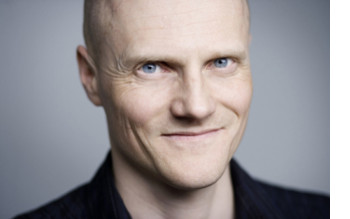 This month, I reviewed Stian Hole’s Anna’s Heaven, released by Eerdman’s in September, for BookPage. That review is here.
This month, I reviewed Stian Hole’s Anna’s Heaven, released by Eerdman’s in September, for BookPage. That review is here.
You all know I like to follow up reviews with art from the books I write about, if possible, but for this one I also decided to chat with the award-winning illustrator himself (pictured here) about this book, what’s next for him, how picture books differ in the U.S. and overseas, and more. In fact, he poses a question to readers below (regarding U.S. publishing), if anyone is so inclined to weigh in.
The chat today includes art from Anna’s Heaven, as well as a couple of older picture book titles of Stian’s, published here in the States. Stian also shares images from a forthcoming book, which will also be published here.
Let’s get right to it, and I thank him for visiting.
Jules: Your photocollage work is beguiling. I imagine you always on the look-out for vintage photographs and vintage books. Am I right? Where do you typically find source material?
Stian: Yes, I am a collector of bits and pieces that I move around and try to put together. That is what I do for a living. Like in a theater, I have a huge prop stock. By the way, have you noticed all the things theatre and picturebooks have in common?
Some years ago I used to search libraries and second-hand bookshops. Now, databases and collections on the internet have opened up new possibilities. Isn´t it amazing what people out there collect?
Most of the time I find something other than what I am looking for, though. So, more and more often I take a walk instead and use the camera on my cell phone.
Jules: Yes, in Uri Shulevitz’s Writing with Pictures, he says that a picture book is closer to theater and film—silent films, in particular—than other kinds of books. Fascinating.
I love that you honor open endings in your picture books. Americans, it seems, get sort of twitchy sometimes about open endings. What do you think are some of the biggest differences between children’s book publishing here in the States and overseas?
Stian: Your question is interesting, but too big for me to answer, I am afraid. Hmm, I will try to find a way …
I wonder why someone would feel insecure about open endings in children´s literature. Life isn´t always a safe place, so why should it be in picture books? Wouldn´t it be a fraud to tell children that life is always sweet? Anyway, I think kids already know it isn’t so. I believe picture books are a quiet—and safe—meeting place for wonder and reflection. Picture books are often read by adults and children together, and they give a valuable opportunity for thoughts, conversation, and mind-traveling for people of different ages. It is a magic place for opening secret doors, for listening and sharpening your senses.
Anyway, I believe what is scary in life becomes less scary when you speak with someone about it.
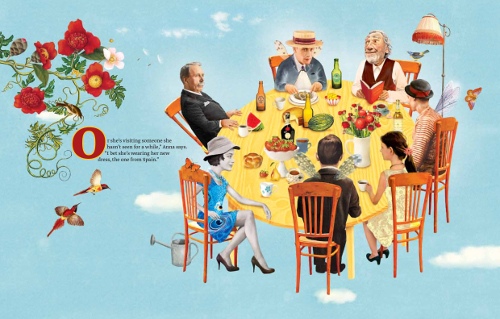
‘I bet she’s wearing her new dress, the one from Spain.'”
— From Anna’s Heaven
(Click to see spread in its entirety)
It is a good thing when books travel. I wish more books could travel across borders. When I follow my books around, I sometimes get small glimpses of other cultures´ traditions and views on children´s literature. I love to meet people that think differently than I do. It makes me think.
One difference I have noticed across the Atlantic sea, though, is that for some reason I don´t quite understand there is sometimes—or rather in some places in the U.S.—a reluctance of skin, nakedness, and sexuality in children´s and young adults´ books. The U.S. is the only country who has asked me to put more clothes on the characters in my images or else they will not publish them. I once had to remove a boy that was peeing, for some reason. Not even the Arabic countries asked me to do that.
So, I try to turn my head upside-down and look at Nordic picturebooks from the other side of the sea. But I find it difficult to see oneself. Can someone of your readers help me? Anyway, I must say that my publisher in the U.S. has always been thorough and honest with me, and I must pay tribute to them for publishing my weird books.

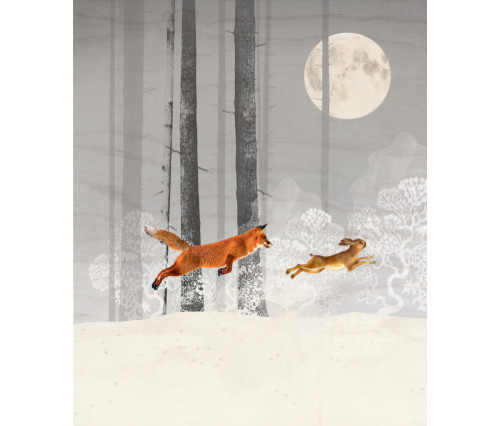

Nightguard with poems by Synne Lea
Jules: I don’t have an answer for that, but perhaps some blog readers will weigh in with some thoughts.
Did anything in particular from your life inspire Anna’s Heaven?
Stian: I usually only have a starting point when I start working on a story. That is all I have; the rest is a strange journey, sometimes fragile and frustrating, sometimes sweet and joy-filled.
In this case, I saw a girl hanging upside-down in a swing and remembered doing the same thing as a boy. It made me stop and think that I still want to do that as an author and illustrator: to turn things upside-down and see the world from another angle! So I realized it was something I had to investigate further.
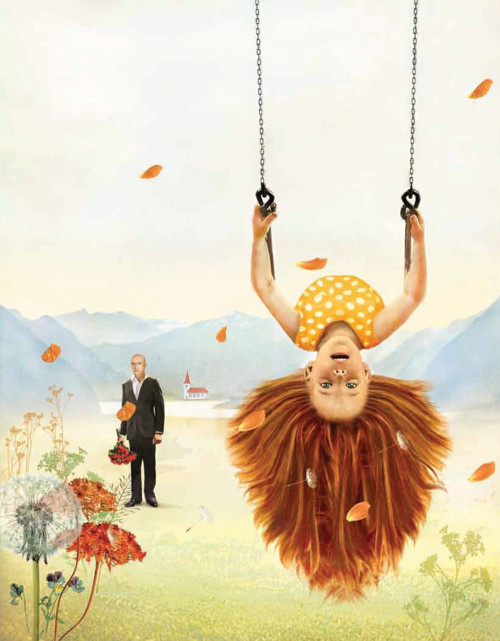
‘Like redder.’ ‘And Anna,’ Dad says. ‘Hurry up now or we’ll be late.’ Even though she is looking away, Anna notices that her father is restless. She can feel it in the air, in the grass, in the scar on her knee, in the mole on her neck, and in every hair on her head. Anna knows that her dad gets restless when he is not looking forward to something.”
— Opening spread from Anna’s Heaven
(Click to see spread in its entirety)
Along the way, many things inspired me — memories, personal experiences, and lots of influences from different people. When I work on a story, I always keep an alert eye and ear for things I might use in the story. Not only pieces for the illustrations, but also words, feelings, and incidents. Anything. Often I find something else than what I was looking for, things that catch my attention but probably don´t belong in the story. Nevertheless, I pick them up, write it down, and sometimes use it later in another story. You know, people like me are collectors and researchers. One of my favourite authors, Peter Høeg from Denmark, once said, “I am a scientist. I investigate my heart.”

— Final spread from Anna’s Heaven
(Click to see spread in its entirety)
Jules: How much do the illustrations, as you’re working on them, inform the text — if at all? (Or vice versa.)
Stian: In picturebooks, the images and the text should not say quite the same. It is the dialogue between them that is the engine of the picturebook. The third hub is the reader. The author should strive to open up the story, so different readers can add thoughts and help co-write the book. Books do not work without readers.
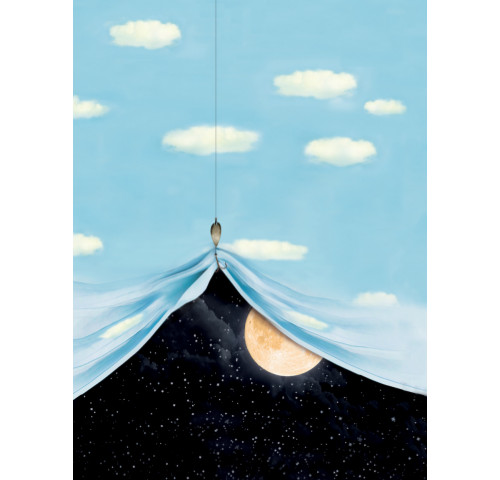
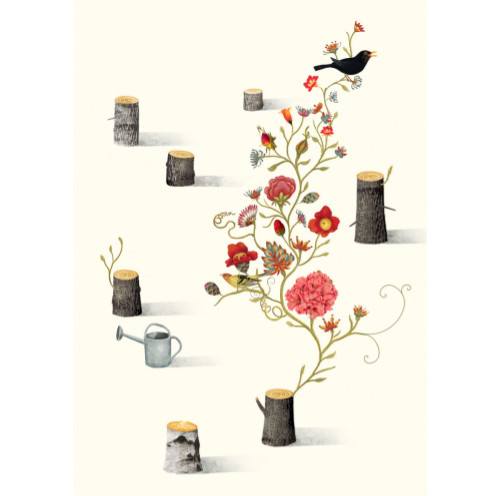
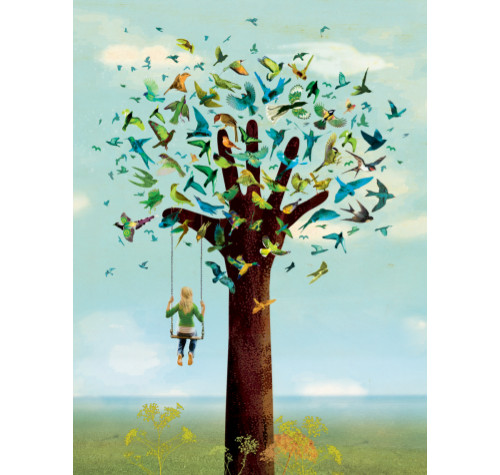
Jules: What are you reading now?
Stian: I am always reading. Right now, I’m reading A Constellation of Vital Phenomena by Antony Marra. And poetry in the evening before sleep.
Many of the American classics have had an impact on my artistic life — J. D. Salinger’s The Catcher in the Rye, Edgar Lee Masters´ Spoon River Anthology, Fitzgerald´s The Great Gatsby. I must also mention the Canadian writer Alice Munro´s short-stories, among many others.
Jules: On that note, what picture books have you loved lately? Or whose work have you seen that you think deserves some love and attention?
Stian: I just read The Rules of Summer by Shaun Tan from Australia. I love his work. The same with Isol (Argentina), Beatrice Alemagna (Italy), and Kitty Crowther (Belgium).
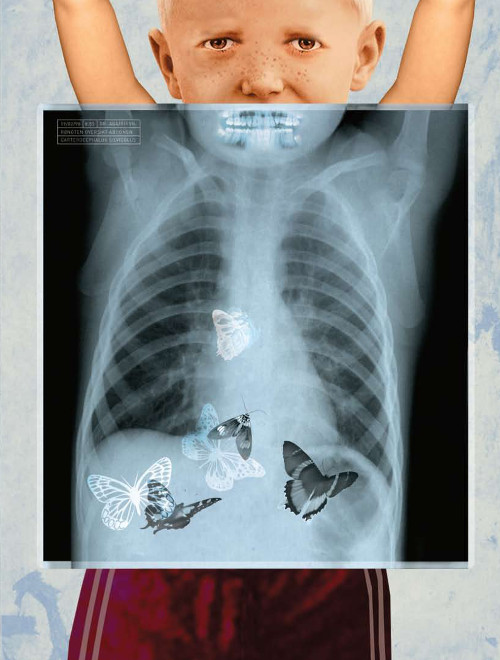
Auntie Borghild asks. ‘I’m scared,’ Garmann answers,
wondering how butterflies get into your stomach.”
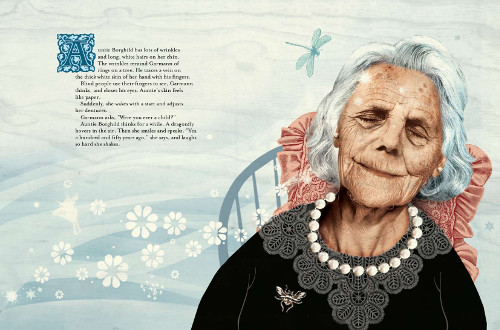
Then she smiles and speaks. ‘Yes, a hundred and fifty years ago,’
she says, and laughs so hard she shakes.”
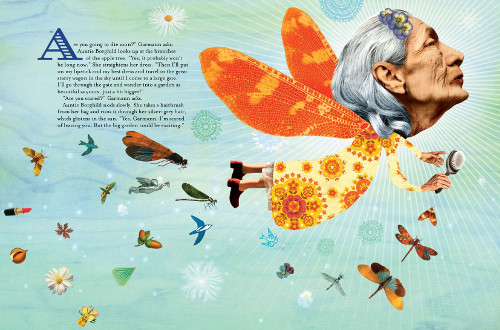
Auntie Borghild nods slowly. She takes a hairbrush from her bag and runs it through her silver-grey hair, which glistens in the sun. ‘Yes, Garmann, I’m scared of leaving you. But the big garden could be exciting.'”

but first of all you have to be buried.”

released by Eerdmans in 2008, but originally published in Norway in 2006.
Click each image above to enlarge and read the full text.]
Jules: What do you, as an artist, find most challenging and satisfying in the creative processes you employ?
Stian: That is a good question. I often feel that reading and writing stories have something important in common. They makes me feel like I live multiple lives. I am thankful for that. It is very satisfying to live parallel lives, since only one life can feel so short. I am also grateful whenever art open doors inside me, to rooms and places that I have not visited for a while or maybe never been. Sometimes art open the doors all the way to my heart.
But sometimes when I am daydreaming, falling down the rabbit hole, floating inside a bubble, working on a story, I get afraid that I am not present enough in reality. Then I promise myself to hug and tell my wife and my boys that I love them when they come home from school and work. These things feel so important in my life, but hard to explain — does it make sense to you?

Garmann answers, pretending to adjust a telescope. ‘Hello, Planet Earth! This is Comrade Yuri Gagarin, the first man in space. I can’t see God up here,’ he says, disguising his voice. ‘Hello, Ground Control heer. That’s probably because
you don’t know what you’re looking for!’ Johanna laughs…”
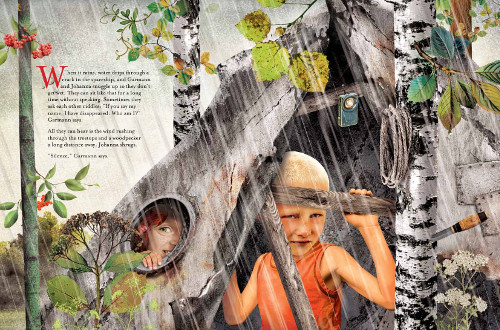
‘If you say my name, I have disappeared.
Who am I?’ Garmann says. All they can hear is the wind rushing through the treetops and a woodpecker a long distance away. Johanna shrugs. ‘Silence,’ Garmann says.”
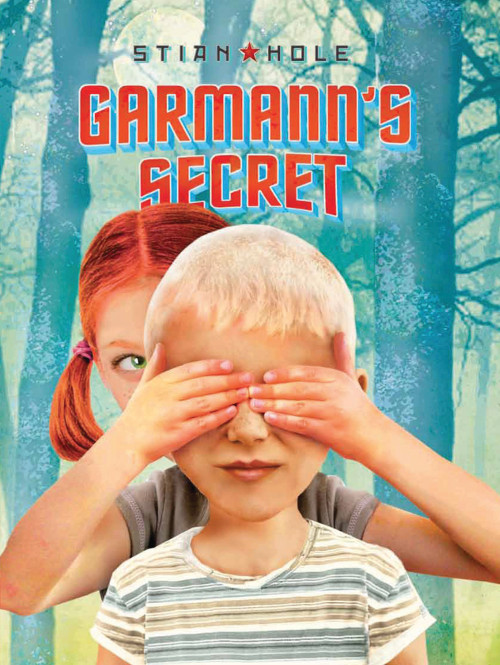
released by Eerdmans in 2011, but originally published in Norway in 2010.
Click each image above to enlarge and read the full text.]
Jules: Yes, that makes sense to me. Art is taking you outside of yourself. My favorite singer-songwriter/musician, Sam Phillips, has this lyric in one of her songs (called “Lever Pulled Down”):
I’m a lever pulled down / I’m a flipped switch / I’m a lever pulled down / from the fire in the air / … and I’ll give my life for the lightning in our dreams …
I think that’s what you mean. Perhaps.
(I wish I could link to the song, but it’s one of her rare tracks and not online.)
p.s. I have a Sam Phillips lyric for EVERYTHING in life.
So, what’s next for you?
Stian: Soccer. All three boys are playing matches this weekend, and I will be there. On Sunday, I am goalkeeper when the Norwegian author´s team meets the Italian author´s team. They have come all the way to Oslo.
Then there will be new stories to write. Always. I hope the next book will be a love story. I want all my books to be love stories.
Photo of Stian Hole taken by Jo Michael.
All artwork here is used by permission of Stian Hole and Eerdmans Books for Young Readers, Grand Rapids, Michigan.


Oh what a wonderful post, I love what Stian says about
open endings. I think it the U.S. there is a tendency to play it safe, parents want to protect their kids from what they think might harm them to talk about: sex, poo, death. In European books there seems to be more courage and acceptance to deal with such themes and a belief that it actually helps kids. I think American children would have no problem with the books that are popular here in Europe, but some parents would.
Hi Stian. You are awesome. I can honestly say I am grateful to have stumbled upon your work. In regards to your question about modesty, sexuality in the U.S. Its in part due to religious doctrines. Im from the midwest, Chicago to be exact and there is a certain shame associated with nudity here. I have many friends from Eastern Europe and they are free and open with sexuality & I appreciate this. But also it can distract the senses if you are not used to it. I believe also that modesty plays a role and can be appreciate because the body can be looked at as a temple. I have studied contemplative religious studies for many years and many religions see the body and sexuality as very powerful entities that can be abused if not taken with some care. I love that there are countries that are free and see everything as natural and coming from the creator but also I like mystery and the unveiling of something hidden.
Anita
avalentin30@gmail.com
[…] A Conversation with Norwegian Author-Illustrator Stian Hole at blaine.org […]
[…] ” In picturebooks, the images and the text should not say quite the same. It is the dialogue b… ~Stian Hole […]